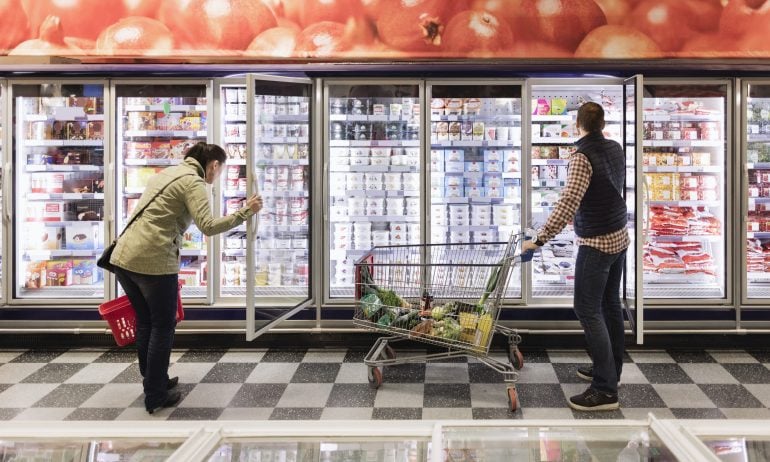After Years of High Prices, Will Tariffs Reignite Food Inflation?
Higher operating costs, supply-chain disruptions and corporate profits have contributed to high food prices since 2019.

Many, or all, of the products featured on this page are from our advertising partners who compensate us when you take certain actions on our website or click to take an action on their website. However, this does not influence our evaluations. Our opinions are our own. Here is a list of our partners and here's how we make money.
Updated April 10.
The high inflation rates that pushed up food prices since the pandemic have cooled off significantly in the past year or more. But now, tariffs are expected to push prices higher once again: An analysis by the Yale Budget Lab estimates current tariff rates will cause food prices to rise 2.6% in the short term. Once businesses and consumers shift their purchases in response to the tariffs, the analysis estimates prices will stick around 3% higher.
Sweeping global tariffs affecting virtually all U.S. trade partners are now in effect. For details, see:
No single factor can explain why food is so much more expensive now than before the pandemic. Food prices — which are up 31% since 2019 — remain high because of the combined impact of rising input costs, supply chain disruptions and corporate profits. Higher tariffs currently in effect on some imported food could further fuel inflation.
Higher production, labor and fuel costs have rippled through every aspect of the food system.
Supply chain disruptions caused by global events, severe weather and disease have affected many essential crops and livestock.
Some food companies that sought to maintain — or increase — profitability while facing these volatile conditions.
New tariffs enacted by the Trump administration will likely raise prices on many food items long supplied by foreign trade partners.
Some of these factors affect food production across the board while others affect only some products. Here’s a deeper look at why food prices are high.
» MORE: How is the economy doing?
News moves fast. Stay ahead of how it could impact your money.
Interest rates, inflation, natural disasters — get notified when breaking news could affect your finances, and get expert insights to help you plan your next move.

Operating costs
From farm to supermarket, everyone has people to pay, equipment or raw materials to buy and vehicles to fuel. And those operating costs have become more expensive over the past few years. That adds to the cost of the food you purchase at the store in more than one way.
The simplest way is that the higher costs get passed along. For example, when gas prices rise, the cost of food tends to rise. The price of a gallon of diesel — which fuels farm equipment as well as trucks delivering inventory to stores — increased 22% since the start of 2020, according to U.S. Energy Information Administration data as of Feb. 10.
A more complicated way higher operating costs lead to higher prices at the grocery store can be illustrated with one staple that’s stubbornly expensive right now: Beef. Years of drought, high grain prices and rising interest rates made cattle farming so expensive that many U.S. farmers reduced the size of their herds to cut costs — and some got out of the business altogether. Now, the U.S. cattle inventory is the smallest it’s been since 1951. That huge drop in supply has pushed prices for ground beef and sirloin steak to all-time highs.
Supply-chain disruptions
Sudden, sometimes unavoidable events can create supply shocks that drive up food prices. The sources and intensity of those supply shocks vary. Here are just a few examples of events that recently impacted food supplies and sent prices soaring.
The pandemic created a sudden surge in demand for groceries as lockdowns forced people to stay home. At the same time, food production slowed as COVID-19 spread and workplaces enacted new protocols meant to mitigate health risks to employees. You might remember items like yeast or meat became almost impossible to find. Prices for popular items soared as grocery stores and their suppliers struggled to keep up with consumers.
The war in Ukraine continues to affect that country’s food exports. As “the breadbasket of Europe,” Ukraine historically accounted for 9% of the global wheat market and 12% of the corn market, according to the USDA’s Foreign Agricultural Service.
A highly contagious and fatal bird flu first appeared in U.S. poultry at the start of 2022 and has wreaked havoc on the national population of egg-laying hens since then. Consequently, egg prices have been volatile, surging to $6.23 per dozen in March — a new record.

Corporate profits
Despite the headwinds described above, grocery stores’ profit margins increased in recent years, according to a March 2024 report by the Federal Trade Commission. The FTC report notes that food and beverage retailers saw their revenues outpace their costs by more than 6% in 2021. That was a new high for that particular profit measure until 2023, when it reached 7%.
Food manufacturers have relied on price hikes and other tactics to maintain profitability, as well. Take chocolate for example, which has become even more expensive to make this year because of record-high cocoa prices. Companies saw shoppers become more sensitive to chocolate prices as they went up. While shoppers spent more money on chocolate in each of the past two years, they actually cut back on the quantities they bought, according to NielsenIQ data provided to NerdWallet in March 2024.
When that happens, companies know they can’t keep raising prices without further impacting their sales volume. Instead, they make other product changes, like shrinking packages, giving you less product for the same price. That maneuver is known by detractors as shrinkflation.
Members of Congress and the Biden administration have taken turns slamming food companies for these tactics. President Joe Biden called out “shrinkflation” during his State of the Union speech in March. And Sen. Elizabeth Warren blamed high grocery prices on “corporate price gouging" during a Senate subcommittee hearing on high food prices in May.
Former FTC Chair Lina Khan wanted the commission to launch an inquiry into big grocery chains’ pricing practices. During an Aug. 1 meeting of the Strike Force on Unfair and Illegal Pricing, an interagency committee targeting corporate pricing in numerous industries, Khan said the FTC wanted to understand why prices remain high even as costs have declined and supply chains have improved. “We want to make sure that major businesses are not exploiting their power to inflate prices for American families at the grocery store.”
Tariffs
After taking office in January, President Donald Trump began imposing tariffs that have the potential to usher in a new trade era.
Nailing down specific impacts remains difficult since tariffs and rates have changed rapidly since February. As of April 10, a 10% baseline tariff is in place for most foreign imports. Automobiles, steel and aluminum and some imports from Canada and Mexico have been hit with 25% tariffs. Certain goods that are included in the U.S.-Mexico-Canada Agreement (USMCA) are exempt.
A Yale Budget Lab analysis shows tariffs are likely to have a considerable initial impact on food prices. How prices are impacted long-term depends on how businesses and consumers shift their purchases in response to tariffs (or whether they can).
The analysis estimates overall food prices could be 2.6% higher in the short term and 3% higher after those substitutions take place. But products will be affected differently. For example, fresh produce prices could go up 5.4% in the short term before settling about 3.9% higher in the long term.
The U.S. imported roughly $216.1 billion worth of food in 2024, according to U.S. Census Bureau data. Those imports included:
Fruit and fruit juices
Fish and shellfish
Bakery products
Vegetables
Meat products
Wine, beer and other alcoholic beverages
Food oils
Unroasted coffee
Dairy products and eggs
Tea and other spices
Nuts
Sugar
Cocoa beans
Some food prices could be heavily impacted because many imported items (like coffee beans, cocoa, and some fruits) can’t be sourced domestically; other items aren’t produced at enough scale to meet current U.S. demand.
Will food prices go down in 2025?
Food prices have continued to rise so far in 2025.
In March — before many of the new tariffs took effect — food prices increased 0.4% from the previous month, according to the consumer price index report released April 10 from the Bureau of Labor Statistics. The CPI, which serves as a proxy for inflation, measures changes in average costs of items in a given period. Food prices include food at home (groceries) and restaurant purchases.
The report shows food prices are 3% higher than they were 12 months ago. By comparison, the annual food inflation rate in March 2024 was 2.2%.
Grocery prices were 2.4% higher year-over-year in March. More on that below.
Restaurant prices were 3.8% higher year-over-year. Specifically:
Full-service meals (at sit-down restaurants) cost 4.1% more year-over-year.
Limited service meals (takeout only) cost 3.4% more compared to the same time last year.
How inflation is hitting your grocery bill
On the whole, grocery price inflation ticked up in the latest CPI report. The grocery index increased 0.5% between February and March because price hikes in most of the major grocery store food groups offset price drops in a couple others.
It’s a good reminder that food prices don’t move uniformly, and overall inflation tends to be driven by price volatility in a few categories. For example:
Egg prices jumped 5.9% from February to March, according to the report. Eggs cost roughly 60% more than they did a year ago.
Beef and veal prices rose 1.2% in the past month. They’re 8.6% higher than a year ago.
Other protein sources like dairy products, pork and poultry saw average price increases month-over-month, as well.
Two major food groups saw average price declines: fruits and vegetables, as well as cereals and bakery products.
How are food prices tracked?
Food prices are tracked by several federal agencies, including the Bureau of Labor Statistics and the Bureau of Economic analysis.
The Bureau of Labor Statistics tracks the CPI, which measures the change in average price that consumers pay for goods and services, including food. So the CPI is also a measure of inflation.
In the CPI, the cost of food is of high relative importance to the overall index, compared to the other tracked goods and services. Food costs make up 13.4% of the index, to be exact. Its importance is second only to shelter (34.73%). But food prices, like energy, also tend to be more volatile, and for that reason it is usually left out of the “core inflation” version of the index.
The Bureau of Economic Analysis measures the personal consumption expenditures price index. The PCE tracks how much consumers spend on goods and services, as well as how consumers change spending habits in response to price shifts. Food is considered a non-durable good in its analysis. Core PCE — the Federal Reserve’s preferred measure of inflation — also excludes food and energy.
The U.S. Department of Agriculture measures the cost of different food plans. These plans are adjusted each month, based on CPI data and average family income levels: thrifty or low, moderate and liberal. The Thrifty Food Plan is the basis for the Supplemental Nutrition Assistance Program, or SNAP.

